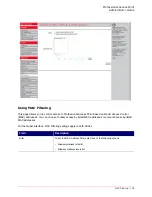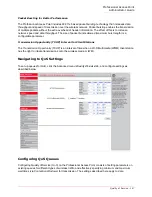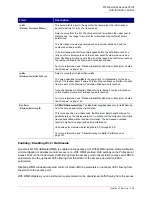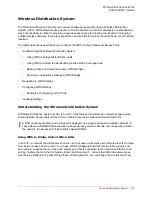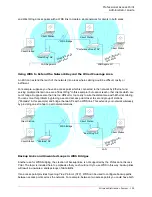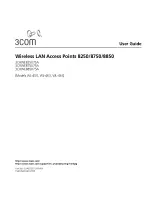
Professional Access Point
Administrator Guide
Quality of Service - 143
Quality of Service
Quality of Service (
QoS
) provides you with the ability to specify parameters on multiple queues for
increased throughput and better performance of differentiated wireless traffic like
Voice-over-IP
(VoIP);
other types of audio, video, and streaming media; and traditional IP data.
The following sections describe how to configure Quality of Service queues on the Professional Access
Point:
•
Understanding QoS
•
QoS and Load Balancing
•
802.11e and WMM Standards Support
•
QoS Queues and Parameters to Coordinate Traffic Flow
•
Navigating to QoS Settings
•
Configuring QoS Queues
•
Configuring AP EDCA Parameters
•
Enabling/Disabling Wi-Fi Multimedia
•
Configuring Station EDCA Parameters
•
Updating Settings
Understanding QoS
A primary factor that affects QoS is network congestion due to an increased number of clients attempting
to access the air waves and higher traffic volume competing for bandwidth during a busy time of day. The
most noticeable degradation in service on a busy, overloaded network will be evident in time-sensitive
applications like video,
Voice-over-IP
(VoIP), and streaming media.
Unlike typical data files, which are less affected by variability in QoS, video, VoIP and streaming media
must be sent in a specific order at a consistent rate and with minimum delay between
Packet
transmissions. If the quality of service is compromised, the audio or video will be distorted.
QoS and Load Balancing
By using a combination of load balancing (see “Load Balancing” on page 139) and QoS techniques, you
can provide a high quality of service for time-sensitive applications, even on a busy network. Load
balancing is a way of better distributing the traffic volume across access points. QoS is a means of
allocating bandwidth and network access based on transmission priorities for different types of wireless
traffic within a single access point.
802.11e and WMM Standards Support
QoS
describes a range of technologies for controlling data streams on shared network connections. The
Summary of Contents for Instant802 APSDK
Page 1: ...Professional Access Point Administrator Guide R46 1224 00 rev 2 0 07 06...
Page 2: ......
Page 4: ...Professional Access Point Administrator Guide iv...
Page 8: ...Professional Access Point Administrator Guide viii...
Page 42: ...Professional Access Point Administrator Guide Basic Settings 42...
Page 52: ...Professional Access Point Administrator Guide Access Points 52...
Page 58: ...Professional Access Point Administrator Guide User Management 58...
Page 62: ...Professional Access Point Administrator Guide Sessions 62...
Page 70: ...Professional Access Point Administrator Guide Channel Management 70...
Page 88: ...Professional Access Point Administrator Guide Neighboring Access Points 88...
Page 96: ...Professional Access Point Administrator Guide Ethernet Wired Settings 96...
Page 120: ...Professional Access Point Administrator Guide Security 120...
Page 128: ...Professional Access Point Administrator Guide Virtual Wireless Networks 128...
Page 134: ...Professional Access Point Administrator Guide Radio 134...
Page 138: ...Professional Access Point Administrator Guide MAC Filtering 138...
Page 152: ...Professional Access Point Administrator Guide Quality of Service 152...
Page 160: ...Professional Access Point Administrator Guide Wireless Distribution System 160...
Page 164: ...Professional Access Point Administrator Guide Time Protocol 164...
Page 170: ...Professional Access Point Administrator Guide SNMP 170...
Page 290: ...Professional Access Point Administrator Guide Configuration Troubleshooting 290...
Page 298: ...Professional Access Point Administrator Guide Regulatory Information 298...
Page 328: ...Professional Access Point Administrator Guide Index 328...








